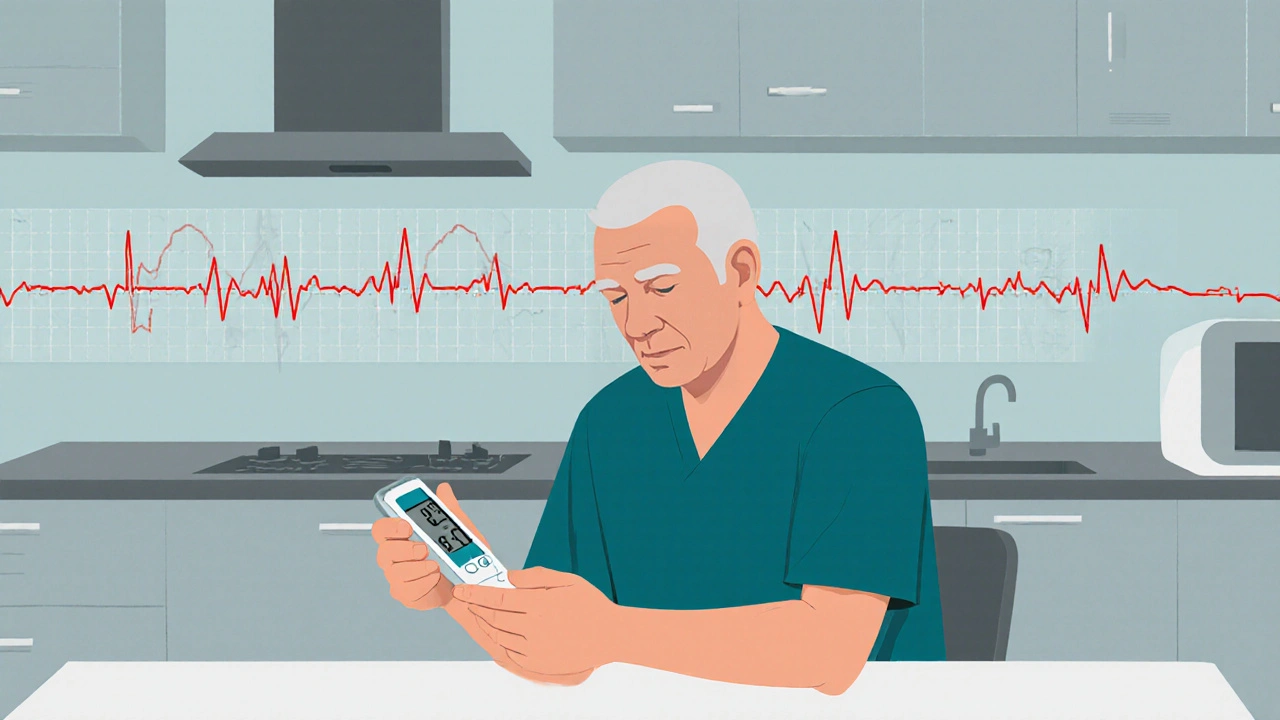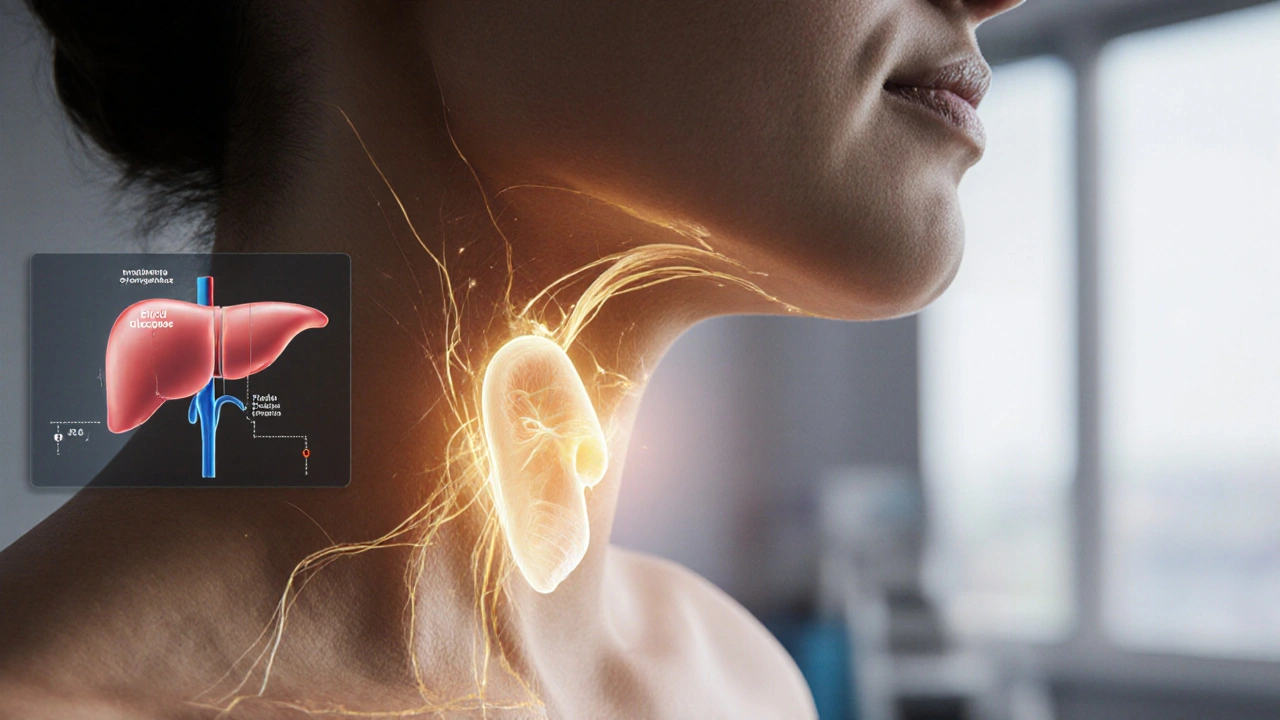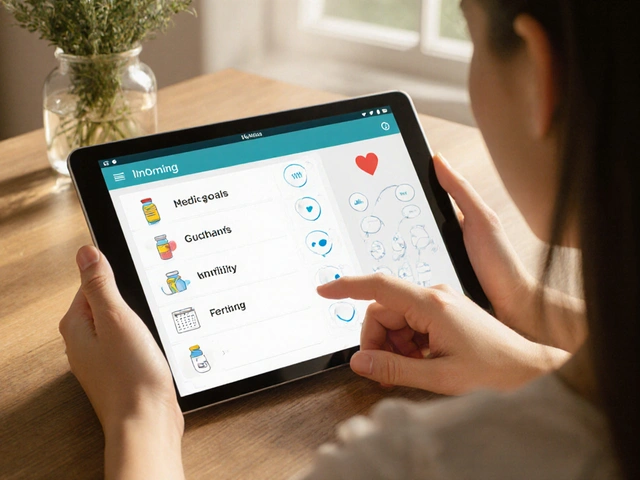Hyperthyroidism & Diabetes Symptom Checker
Answer the following questions about your current symptoms. This tool helps identify potential overlaps between hyperthyroidism and diabetes.
Ever wonder why a thyroid problem can suddenly throw your blood‑sugar numbers off? You’re not alone. When the thyroid goes into overdrive, it can mess with the way your body uses insulin, making diabetes management a lot trickier. This guide walks you through the biology, the symptoms you should watch for, and practical steps to keep both conditions under control.
What is Hyperthyroidism?
Hyperthyroidism is a medical condition where the thyroid gland produces too much thyroid hormone, primarily thyroxine (T4) and triiodothyronine (T3). These hormones accelerate metabolism, raise heart rate, and increase heat production. Common causes include Graves’ disease, toxic nodular goitre, and thyroiditis.
Typical signs are weight loss despite appetite, nervousness, tremors, heat intolerance, and rapid heartbeat. Laboratory tests show a low thyroid‑stimulating hormone (TSH) level because the pituitary gland tries to curb the hormone surge.
What is Diabetes?
Diabetes is a chronic disorder affecting how the body regulates blood glucose. Type1 diabetes stems from autoimmune destruction of insulin‑producing beta cells, while Type2 diabetes results from insulin resistance and often a relative insulin deficiency.
Both types share long‑term risks such as cardiovascular disease, kidney damage, and nerve problems. Management revolves around monitoring blood glucose, medication (insulin or oral agents), and lifestyle modifications.
How Thyroid Hormone Affects Blood Sugar
Thyroid hormones influence virtually every tissue that uses glucose. The main mechanisms are:
- Increased hepatic glucose output: T3 stimulates gluconeogenesis, flooding the bloodstream with glucose.
- Enhanced gastrointestinal absorption: Faster gut motility can lead to more rapid carbohydrate uptake.
- Accelerated insulin clearance: The liver breaks down insulin quicker, reducing its effective half‑life.
- Heightened sensitivity to catecholamines: Stress hormones become more potent, pushing glucose higher.
Because of these effects, patients with hyperthyroidism often experience higher fasting glucose and more frequent spikes after meals, even if their diabetes regimen hasn’t changed.

Clinical Signs When Both Conditions Co‑exist
If you already have diabetes and develop hyperthyroidism, look for the following red flags:
- Sudden rise in HbA1c (often >0.5% within a few weeks).
- Unexplained nocturnal hypoglycemia followed by morning hyperglycemia.
- Weight loss that outpaces diet changes.
- Palpitations combined with tremors that feel different from typical hypoglycemia shakiness.
- Increased frequency of urination beyond what high blood sugar would predict.
Seeing any of these patterns should prompt a thyroid function test. Early detection prevents a cascade of dosage adjustments and reduces the risk of severe complications.
Managing Medication and Dosage
Balancing antithyroid treatment with diabetes medication requires coordination. Here’s a practical roadmap:
- Start with a baseline: Record fasting glucose, post‑meal readings, and HbA1c before initiating antithyroid drugs.
- If you’re on antithyroid medication such as methimazole, expect a gradual reduction in thyroid hormone levels over 4‑6 weeks. During this phase, insulin requirements may drop by 10‑20%.
- For patients on Metformin, monitor renal function closely-hyperthyroidism can increase renal blood flow, altering drug clearance.
- Adjust basal insulin first, then bolus doses, to avoid swinging between hypoglycemia and hyperglycemia.
- Consider adding a beta‑blocker (e.g., propranolol) to blunt sympathetic surges that raise glucose.
Frequent glucose checks-four times a day during the first month of thyroid treatment-help you fine‑tune doses without waiting for the next clinic visit.
Lifestyle Adjustments for Dual Diagnosis
Beyond medication, a few everyday habits make a big difference:
- Nutrition: Choose complex carbs with fiber (whole grains, legumes) to slow glucose absorption. Add iodine‑rich foods (seaweed, dairy) only if your doctor confirms deficiency; excess iodine can aggravate Graves’ disease.
- Exercise: Moderate aerobic activity (30minutes, 5days a week) improves insulin sensitivity and can temper thyroid‑induced heart‑rate spikes. Avoid high‑intensity bursts without medical clearance, as they may trigger adrenaline‑driven glucose spikes.
- Sleep: Aim for 7-9hours. Sleep loss raises cortisol, compounding both thyroid and glucose dysregulation.
- Stress management: Mind‑body techniques (yoga, meditation) reduce catecholamine output, easing both conditions.
When you eat, try the “plate method”: half non‑starchy veg, quarter lean protein, quarter whole‑grain carbs. This visual cue works well for people juggling two metabolic conditions.

When to Seek Medical Help
Prompt medical attention prevents emergencies such as thyroid storm (a life‑threatening hyperthyroid crisis) or severe hypoglycemia. Call your healthcare provider if you notice any of the following:
- Rapid heart rate >130bpm at rest, accompanied by fever or confusion.
- Blood glucose consistently above 250mg/dL despite medication adherence.
- Repeated episodes of hypoglycemia that require assistance.
- New eye changes (bulging, redness) suggesting Graves’ ophthalmopathy.
Emergency departments can run a quick thyroid panel and adjust insulin infusions in real time, buying you valuable hours.
Key Differences: Hyperthyroidism’s Impact on Type1 vs Type2 Diabetes
| Aspect | Type1 Diabetes | Type2 Diabetes |
|---|---|---|
| Insulin requirement change | Often a 10‑30% increase in basal insulin due to faster insulin clearance. | May see a temporary reduction in oral agent dosage as glucose production rises. |
| Blood‑glucose variability | Higher day‑to‑day swings because of inconsistent insulin absorption. | Elevated fasting glucose; post‑prandial spikes become more pronounced. |
| Common symptoms overlapping | Weight loss is already expected; differentiate by tremor intensity. | Weight loss may be a sign of overt hyperthyroidism rather than improved diabetes control. |
| Treatment priority | Insulin dose adjustment takes precedence; antithyroid meds added after stabilization. | Focus on optimizing oral agents first; consider adding basal insulin if hyperthyroidism persists. |
Quick Takeaway
Understanding the link between hyperthyroidism and diabetes equips you to spot warning signs early, adjust treatment promptly, and stay ahead of complications. Keep a close eye on blood‑sugar trends, get thyroid labs checked when you notice new symptoms, and partner with your endocrinologist for a coordinated plan.
Frequently Asked Questions
Can hyperthyroidism cause diabetes?
Hyperthyroidism itself doesn’t directly cause diabetes, but the excess thyroid hormones can raise blood‑glucose levels and worsen insulin resistance, making it easier for pre‑diabetic individuals to cross the threshold.
Will treating hyperthyroidism improve my blood‑sugar control?
Yes. Normalizing thyroid hormone levels usually reduces hepatic glucose output and slows insulin clearance, which can lower daily insulin needs and bring HbA1c back into target range.
Are there specific foods I should avoid?
Limit high‑iodine foods (e.g., kelp supplements) if you have Graves’ disease, and avoid simple sugars that cause rapid glucose spikes. Focus on high‑fiber carbs and lean protein.
How often should I check my thyroid function?
During the first three months of antithyroid therapy, every 4‑6 weeks is typical. Once stable, a 6‑month interval often suffices, but your endocrinologist may adjust based on symptoms.
Can I exercise if I have both conditions?
Moderate aerobic activity is recommended. It improves insulin sensitivity and helps control heart‑rate spikes from excess thyroid hormones. Always discuss with your doctor before starting high‑intensity workouts.




Jill Brock
October 6, 2025 AT 14:45Guess what happens when your thyroid decides to throw a wild party while your pancreas is trying to keep the house in order-total chaos! The extra thyroid hormones crank up your metabolism faster than a turbocharged engine, sending glucose shooting through the bloodstream. Insulin tries to keep up, but the liver is already dumping more sugar like a reckless bartender. You end up with those dreaded spikes and crashes that make you feel like you’re on a roller coaster you never signed up for. And don’t even get me started on the heart pounding like a drum solo at a rock concert. Bottom line: hyperthyroidism and diabetes are a combustible mix, and you need to tame that fire before it burns you out.
Ellie Chung
October 11, 2025 AT 08:45Picture this: your body’s thermostat is stuck on high, and the sugar meter is doing the cha‑cha‑cha. Thyroid hormones are the over‑enthusiastic DJ, cranking up the beat, while insulin is trying to keep the dance floor from getting too crowded. The result? A dizzying mash‑up of weight loss, jittery nerves, and bathroom trips that never end.
Sophia Simone
October 16, 2025 AT 02:45While the preceding illustration is vivid, it omits critical nuances. Hyperthyroidism does not merely “crank up” metabolism; it specifically up‑regulates hepatic gluconeogenesis via T3‑mediated transcriptional activation, thereby increasing endogenous glucose production independent of dietary intake. Moreover, the accelerated insulin clearance observed in thyrotoxic states necessitates a proportional adjustment in exogenous insulin dosing, particularly in type‑1 diabetes patients. It is also imperative to consider the differential impact on type‑2 patients, wherein insulin resistance may be exacerbated by catecholamine sensitization. Consequently, a simplistic metaphor fails to convey the mechanistic complexities that underlie the clinical presentation.
Juan Sarmiento
October 20, 2025 AT 20:45Hey folks, if you’re juggling both conditions, think of your treatment plan like a well‑orchestrated symphony. Start by logging your blood‑sugar numbers more often-four times a day is a good rhythm during the first month of thyroid meds. When you notice the usual peaks smoothing out, you can gently taper your insulin by about ten percent, but only after checking with your doc. Adding a beta‑blocker can calm those heart‑racing moments, letting you focus on your workouts without the jittery side effects. Remember, consistency and communication with your healthcare team are the keys to keeping everything in harmony.
Patrick McVicker
October 25, 2025 AT 14:45Got it, man 😎. I’ll bump up the glucose checks and keep an eye on the beta‑blocker.
Liliana Phera
October 30, 2025 AT 08:45While the practical advice is sound, let us contemplate the deeper ramifications of constantly monitoring our bodies. Every extra finger prick or data point becomes a reminder of our fragility, nudging us toward a hyper‑awareness that can be mentally taxing. Yet, this vigilance also empowers us, granting insight into the subtle dance between thyroid output and insulin dynamics. By embracing this paradox, we transform what could be a burdensome routine into a mindful practice of self‑care. Ultimately, the balance we achieve is not merely physiological but existential.
Dean Briggs
November 4, 2025 AT 02:45Understanding the interplay between hyperthyroidism and diabetes requires a multi‑layered approach that considers hormonal, metabolic, and lifestyle factors in concert. First, recognize that thyroid hormones accelerate basal metabolic rate, which can lead to increased hepatic glucose production through up‑regulated gluconeogenic enzymes such as PEPCK and G6Pase. Second, the heightened sympathetic activity associated with thyrotoxicosis amplifies catecholamine‑mediated glycogenolysis, contributing further to hyperglycemia. Third, insulin clearance is enhanced, shortening its half‑life and necessitating adjustments in dosing, especially for those on intensive insulin regimens. Fourth, patients often experience weight loss that may mask improvements in glycemic control, obscuring clinical assessment. Fifth, the overlap of symptoms-palpitations, tremors, polyuria-demands careful differential diagnosis to avoid misattribution. Sixth, coordinated care between endocrinologists is essential to synchronize antithyroid therapy with diabetes management plans. Seventh, lifestyle modifications, such as choosing low‑glycemic index carbohydrates and incorporating moderate aerobic exercise, can mitigate some of the metabolic turbulence. Eighth, regular monitoring of thyroid function tests, typically every four to six weeks during the titration phase, provides a feedback loop for therapeutic adjustments. Ninth, patient education empowers individuals to recognize early warning signs of both hypo‑ and hyperglycemia, reducing the risk of acute complications. Finally, adopting a holistic perspective that integrates medical, nutritional, and psychosocial support yields the most favorable outcomes for those navigating both conditions.
Sadie Speid
November 8, 2025 AT 20:45Great breakdown! I always tell my clients to keep a food diary and track their heart rate during workouts-helps spot the spikes early.
Sue Ross
November 13, 2025 AT 14:45I’ve been living with type‑1 diabetes for years, and when my doctor caught my thyroid overactive, the changes were unmistakable. The sudden weight loss and racing heart made me fear a diabetic emergency, but it turned out to be the thyroid acting up.
Rohinii Pradhan
November 18, 2025 AT 08:45Allow me to elucidate the clinical significance of your anecdote with precise terminology. The phenomenon you describe exemplifies the classic presentation of thyrotoxic diabetics, wherein the hypermetabolic state precipitates a catabolic milieu, manifested by involuntary adipose depletion and tachycardia. It is paramount to differentiate these manifestations from insulin‑deficiency‑induced ketoacidosis, as the therapeutic pathways diverge markedly. Moreover, the escalation of basal metabolic rate augments hepatic glucose output via transcriptional activation of phosphoenolpyruvate carboxykinase, thereby compounding hyperglycemic excursions. Prompt thyroid function assays, coupled with a judicious reassessment of insulin regimens, constitute the gold standard of care in such intertwined pathophysiology.
Anna-Lisa Hagley
November 23, 2025 AT 02:45In my analysis, the data points you all share are merely superficial symptoms lacking statistical weight.
A Walton Smith
November 27, 2025 AT 20:45Sounds like a oversimplification.
Theunis Oliphant
December 2, 2025 AT 14:45One must first acknowledge the profound intellectual vacuity inherent in reducing complex endocrine interplay to a mere “oversimplification.” It is an affront to the centuries of scholarly endeavor that have illuminated the subtleties of thyrotoxic metabolism. Indeed, the thyroid gland, when hyperactive, orchestrates a cascade of biochemical events that transcend the simplistic narratives offered by lay observers. The up‑regulation of hepatic gluconeogenic pathways, for instance, is not a trivial footnote but a cornerstone of metabolic dysregulation. Moreover, the accelerated insulin clearance mediated by heightened hepatic perfusion demands a recalibration of exogenous insulin dosages with surgical precision. To ignore these nuances is to betray the very essence of scientific rigor. Furthermore, the sympathetic overdrive engendered by excess thyroid hormones amplifies catecholamine sensitivity, precipitating erratic glycemic fluctuations that defy naïve explanation. Patients, therefore, must be guided by a protocol rooted in evidence, not by cursory anecdotes. The integration of beta‑blockade, antithyroid pharmacotherapy, and meticulous glucose monitoring constitutes a triad of therapeutic prudence. Only through disciplined adherence to this regimen can one hope to restore homeostasis. Let us, then, reject the complacent reductionism that pervades popular discourse and instead elevate the conversation to its deserved academic stature. In doing so, we honor the intellectual legacy of endocrine medicine and safeguard patient well‑being against the perils of ignorance.